Palliative Care Strategies for Health Variation: A Case Study Analysis
VerifiedAdded on 2023/01/18
|8
|2128
|34
Report
AI Summary
This report presents a case study focusing on Mrs. Brown, a 62-year-old woman suffering from COPD and depression. The assignment explores the application of palliative care to improve her health outcomes. The discussion covers the nature of palliative care, its multidisciplinary approach, and its goals in managing chronic illnesses. The report details Mrs. Brown's symptoms, including shortness of breath, chronic cough, and depression, and analyzes the interventions suitable for her condition. These include bronchodilators, inhaled steroids, oxygen therapy, and pulmonary rehabilitation for COPD, as well as psychotherapy and cognitive behavioral therapy for depression. The rationale behind each intervention is provided, emphasizing how palliative care aims to improve the patient's quality of life and address both physical and mental health challenges. The conclusion reinforces the effectiveness of palliative care in managing complex health issues, highlighting the importance of integrated strategies to support patients like Mrs. Brown.
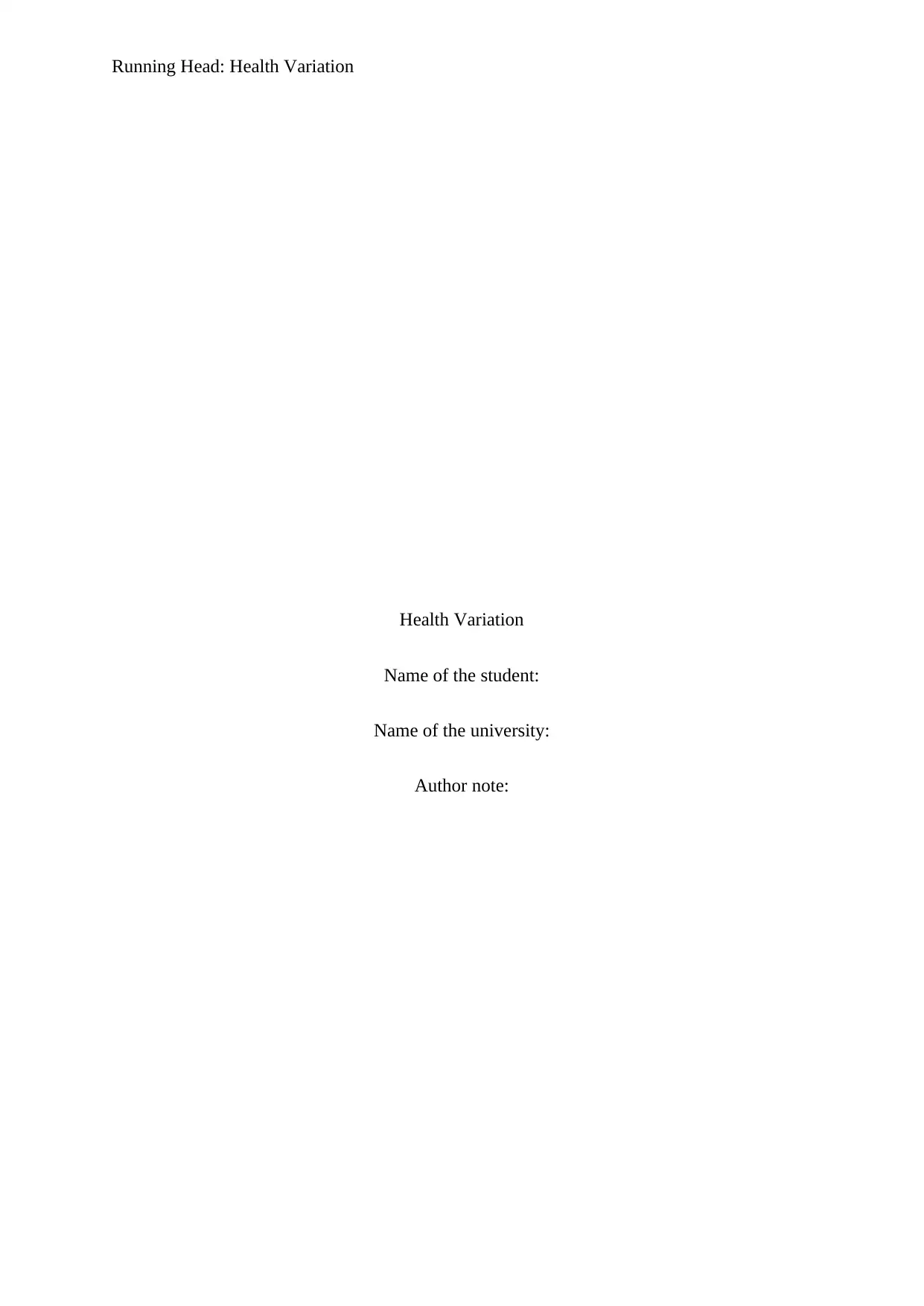
Running Head: Health Variation
Health Variation
Name of the student:
Name of the university:
Author note:
Health Variation
Name of the student:
Name of the university:
Author note:
Paraphrase This Document
Need a fresh take? Get an instant paraphrase of this document with our AI Paraphraser
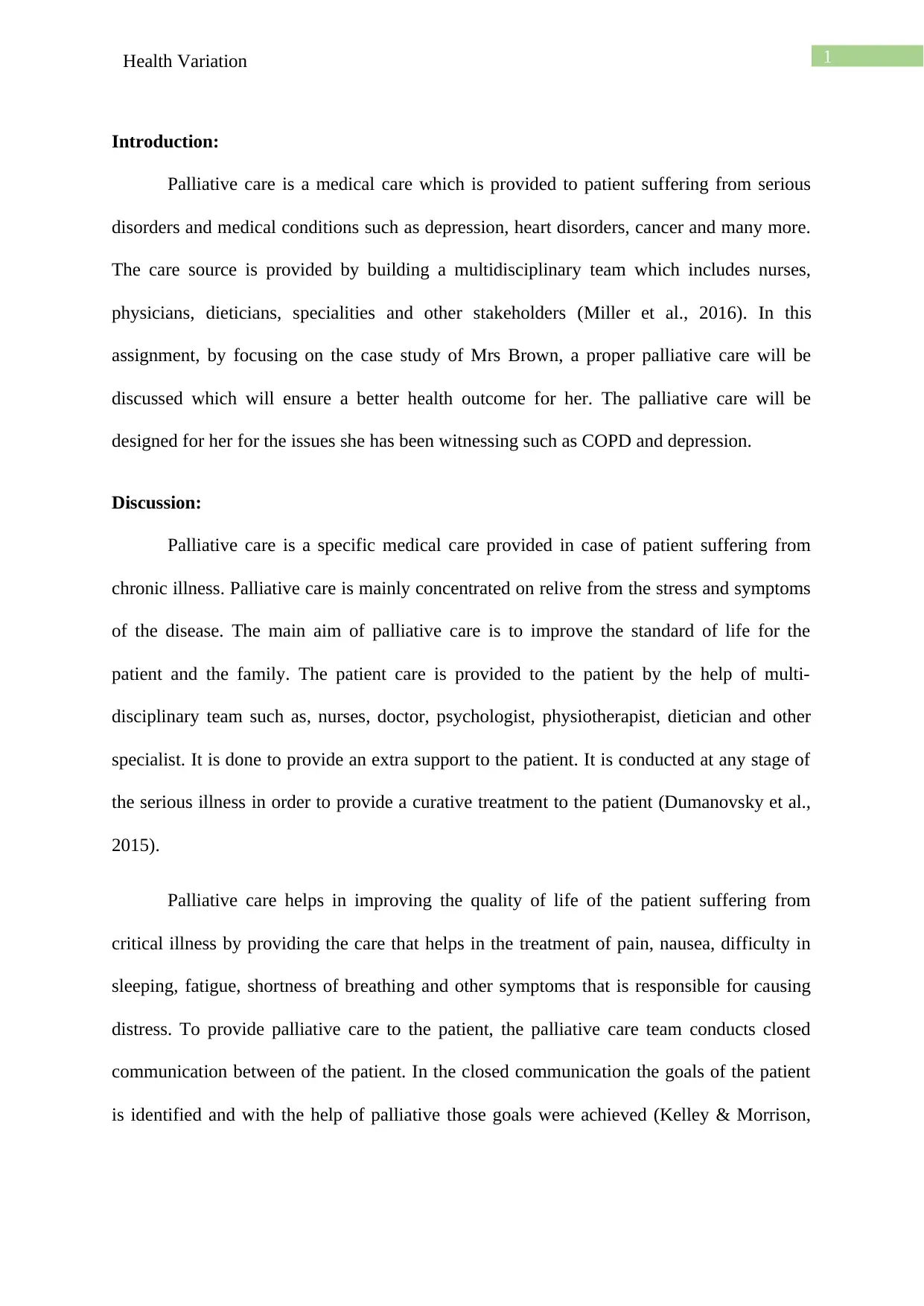
1Health Variation
Introduction:
Palliative care is a medical care which is provided to patient suffering from serious
disorders and medical conditions such as depression, heart disorders, cancer and many more.
The care source is provided by building a multidisciplinary team which includes nurses,
physicians, dieticians, specialities and other stakeholders (Miller et al., 2016). In this
assignment, by focusing on the case study of Mrs Brown, a proper palliative care will be
discussed which will ensure a better health outcome for her. The palliative care will be
designed for her for the issues she has been witnessing such as COPD and depression.
Discussion:
Palliative care is a specific medical care provided in case of patient suffering from
chronic illness. Palliative care is mainly concentrated on relive from the stress and symptoms
of the disease. The main aim of palliative care is to improve the standard of life for the
patient and the family. The patient care is provided to the patient by the help of multi-
disciplinary team such as, nurses, doctor, psychologist, physiotherapist, dietician and other
specialist. It is done to provide an extra support to the patient. It is conducted at any stage of
the serious illness in order to provide a curative treatment to the patient (Dumanovsky et al.,
2015).
Palliative care helps in improving the quality of life of the patient suffering from
critical illness by providing the care that helps in the treatment of pain, nausea, difficulty in
sleeping, fatigue, shortness of breathing and other symptoms that is responsible for causing
distress. To provide palliative care to the patient, the palliative care team conducts closed
communication between of the patient. In the closed communication the goals of the patient
is identified and with the help of palliative those goals were achieved (Kelley & Morrison,
Introduction:
Palliative care is a medical care which is provided to patient suffering from serious
disorders and medical conditions such as depression, heart disorders, cancer and many more.
The care source is provided by building a multidisciplinary team which includes nurses,
physicians, dieticians, specialities and other stakeholders (Miller et al., 2016). In this
assignment, by focusing on the case study of Mrs Brown, a proper palliative care will be
discussed which will ensure a better health outcome for her. The palliative care will be
designed for her for the issues she has been witnessing such as COPD and depression.
Discussion:
Palliative care is a specific medical care provided in case of patient suffering from
chronic illness. Palliative care is mainly concentrated on relive from the stress and symptoms
of the disease. The main aim of palliative care is to improve the standard of life for the
patient and the family. The patient care is provided to the patient by the help of multi-
disciplinary team such as, nurses, doctor, psychologist, physiotherapist, dietician and other
specialist. It is done to provide an extra support to the patient. It is conducted at any stage of
the serious illness in order to provide a curative treatment to the patient (Dumanovsky et al.,
2015).
Palliative care helps in improving the quality of life of the patient suffering from
critical illness by providing the care that helps in the treatment of pain, nausea, difficulty in
sleeping, fatigue, shortness of breathing and other symptoms that is responsible for causing
distress. To provide palliative care to the patient, the palliative care team conducts closed
communication between of the patient. In the closed communication the goals of the patient
is identified and with the help of palliative those goals were achieved (Kelley & Morrison,
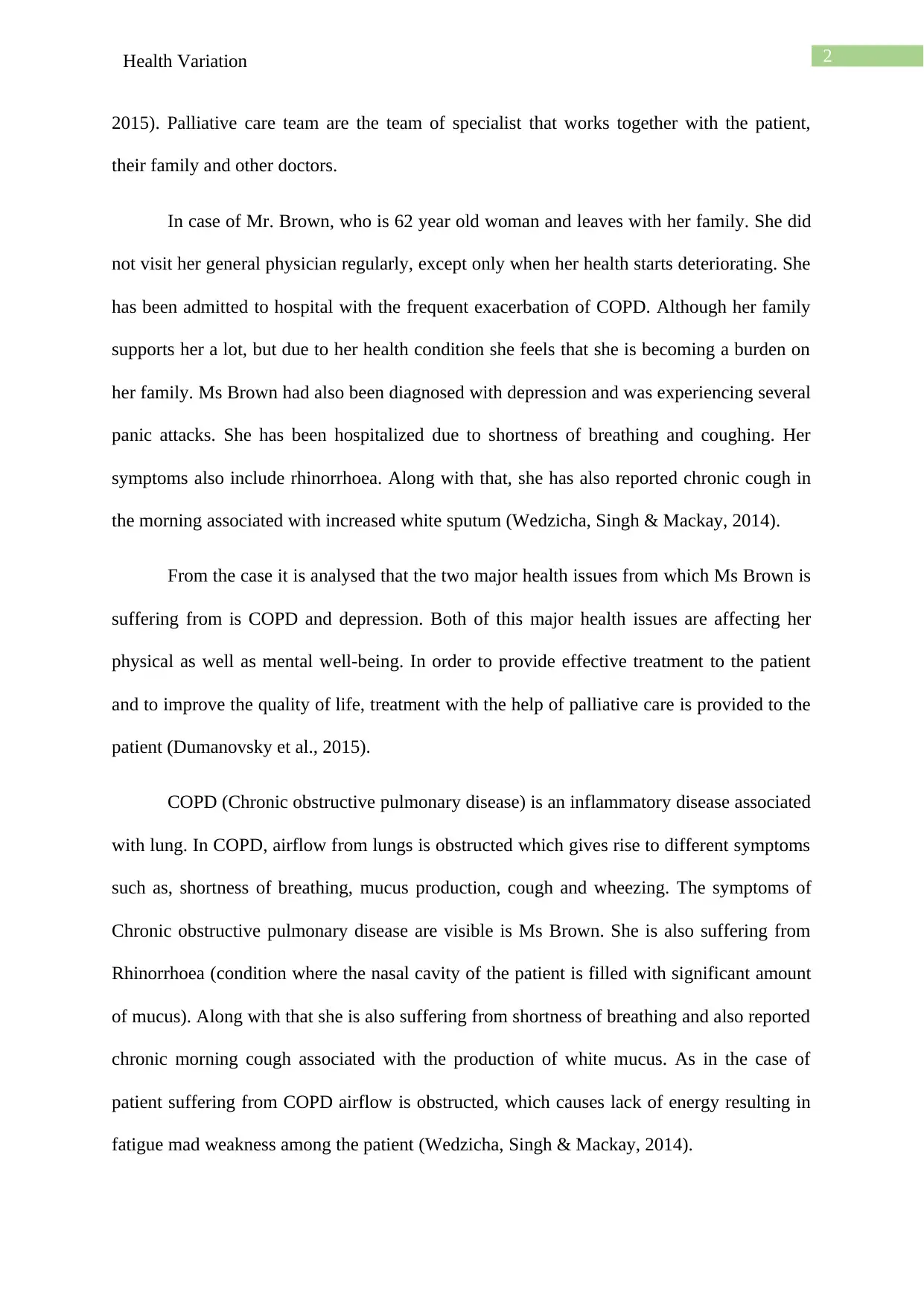
2Health Variation
2015). Palliative care team are the team of specialist that works together with the patient,
their family and other doctors.
In case of Mr. Brown, who is 62 year old woman and leaves with her family. She did
not visit her general physician regularly, except only when her health starts deteriorating. She
has been admitted to hospital with the frequent exacerbation of COPD. Although her family
supports her a lot, but due to her health condition she feels that she is becoming a burden on
her family. Ms Brown had also been diagnosed with depression and was experiencing several
panic attacks. She has been hospitalized due to shortness of breathing and coughing. Her
symptoms also include rhinorrhoea. Along with that, she has also reported chronic cough in
the morning associated with increased white sputum (Wedzicha, Singh & Mackay, 2014).
From the case it is analysed that the two major health issues from which Ms Brown is
suffering from is COPD and depression. Both of this major health issues are affecting her
physical as well as mental well-being. In order to provide effective treatment to the patient
and to improve the quality of life, treatment with the help of palliative care is provided to the
patient (Dumanovsky et al., 2015).
COPD (Chronic obstructive pulmonary disease) is an inflammatory disease associated
with lung. In COPD, airflow from lungs is obstructed which gives rise to different symptoms
such as, shortness of breathing, mucus production, cough and wheezing. The symptoms of
Chronic obstructive pulmonary disease are visible is Ms Brown. She is also suffering from
Rhinorrhoea (condition where the nasal cavity of the patient is filled with significant amount
of mucus). Along with that she is also suffering from shortness of breathing and also reported
chronic morning cough associated with the production of white mucus. As in the case of
patient suffering from COPD airflow is obstructed, which causes lack of energy resulting in
fatigue mad weakness among the patient (Wedzicha, Singh & Mackay, 2014).
2015). Palliative care team are the team of specialist that works together with the patient,
their family and other doctors.
In case of Mr. Brown, who is 62 year old woman and leaves with her family. She did
not visit her general physician regularly, except only when her health starts deteriorating. She
has been admitted to hospital with the frequent exacerbation of COPD. Although her family
supports her a lot, but due to her health condition she feels that she is becoming a burden on
her family. Ms Brown had also been diagnosed with depression and was experiencing several
panic attacks. She has been hospitalized due to shortness of breathing and coughing. Her
symptoms also include rhinorrhoea. Along with that, she has also reported chronic cough in
the morning associated with increased white sputum (Wedzicha, Singh & Mackay, 2014).
From the case it is analysed that the two major health issues from which Ms Brown is
suffering from is COPD and depression. Both of this major health issues are affecting her
physical as well as mental well-being. In order to provide effective treatment to the patient
and to improve the quality of life, treatment with the help of palliative care is provided to the
patient (Dumanovsky et al., 2015).
COPD (Chronic obstructive pulmonary disease) is an inflammatory disease associated
with lung. In COPD, airflow from lungs is obstructed which gives rise to different symptoms
such as, shortness of breathing, mucus production, cough and wheezing. The symptoms of
Chronic obstructive pulmonary disease are visible is Ms Brown. She is also suffering from
Rhinorrhoea (condition where the nasal cavity of the patient is filled with significant amount
of mucus). Along with that she is also suffering from shortness of breathing and also reported
chronic morning cough associated with the production of white mucus. As in the case of
patient suffering from COPD airflow is obstructed, which causes lack of energy resulting in
fatigue mad weakness among the patient (Wedzicha, Singh & Mackay, 2014).
⊘ This is a preview!⊘
Do you want full access?
Subscribe today to unlock all pages.

Trusted by 1+ million students worldwide
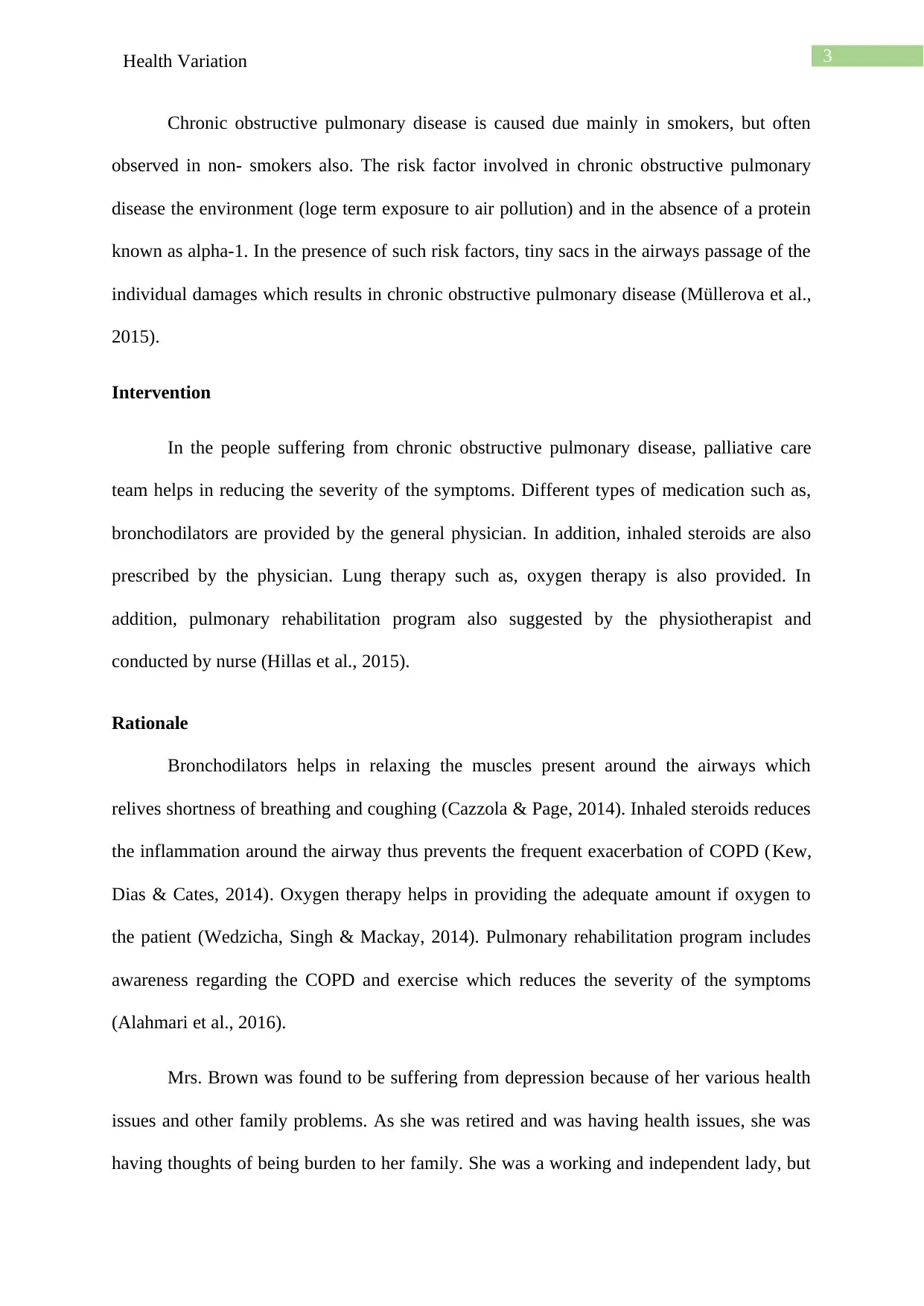
3Health Variation
Chronic obstructive pulmonary disease is caused due mainly in smokers, but often
observed in non- smokers also. The risk factor involved in chronic obstructive pulmonary
disease the environment (loge term exposure to air pollution) and in the absence of a protein
known as alpha-1. In the presence of such risk factors, tiny sacs in the airways passage of the
individual damages which results in chronic obstructive pulmonary disease (Müllerova et al.,
2015).
Intervention
In the people suffering from chronic obstructive pulmonary disease, palliative care
team helps in reducing the severity of the symptoms. Different types of medication such as,
bronchodilators are provided by the general physician. In addition, inhaled steroids are also
prescribed by the physician. Lung therapy such as, oxygen therapy is also provided. In
addition, pulmonary rehabilitation program also suggested by the physiotherapist and
conducted by nurse (Hillas et al., 2015).
Rationale
Bronchodilators helps in relaxing the muscles present around the airways which
relives shortness of breathing and coughing (Cazzola & Page, 2014). Inhaled steroids reduces
the inflammation around the airway thus prevents the frequent exacerbation of COPD (Kew,
Dias & Cates, 2014). Oxygen therapy helps in providing the adequate amount if oxygen to
the patient (Wedzicha, Singh & Mackay, 2014). Pulmonary rehabilitation program includes
awareness regarding the COPD and exercise which reduces the severity of the symptoms
(Alahmari et al., 2016).
Mrs. Brown was found to be suffering from depression because of her various health
issues and other family problems. As she was retired and was having health issues, she was
having thoughts of being burden to her family. She was a working and independent lady, but
Chronic obstructive pulmonary disease is caused due mainly in smokers, but often
observed in non- smokers also. The risk factor involved in chronic obstructive pulmonary
disease the environment (loge term exposure to air pollution) and in the absence of a protein
known as alpha-1. In the presence of such risk factors, tiny sacs in the airways passage of the
individual damages which results in chronic obstructive pulmonary disease (Müllerova et al.,
2015).
Intervention
In the people suffering from chronic obstructive pulmonary disease, palliative care
team helps in reducing the severity of the symptoms. Different types of medication such as,
bronchodilators are provided by the general physician. In addition, inhaled steroids are also
prescribed by the physician. Lung therapy such as, oxygen therapy is also provided. In
addition, pulmonary rehabilitation program also suggested by the physiotherapist and
conducted by nurse (Hillas et al., 2015).
Rationale
Bronchodilators helps in relaxing the muscles present around the airways which
relives shortness of breathing and coughing (Cazzola & Page, 2014). Inhaled steroids reduces
the inflammation around the airway thus prevents the frequent exacerbation of COPD (Kew,
Dias & Cates, 2014). Oxygen therapy helps in providing the adequate amount if oxygen to
the patient (Wedzicha, Singh & Mackay, 2014). Pulmonary rehabilitation program includes
awareness regarding the COPD and exercise which reduces the severity of the symptoms
(Alahmari et al., 2016).
Mrs. Brown was found to be suffering from depression because of her various health
issues and other family problems. As she was retired and was having health issues, she was
having thoughts of being burden to her family. She was a working and independent lady, but
Paraphrase This Document
Need a fresh take? Get an instant paraphrase of this document with our AI Paraphraser
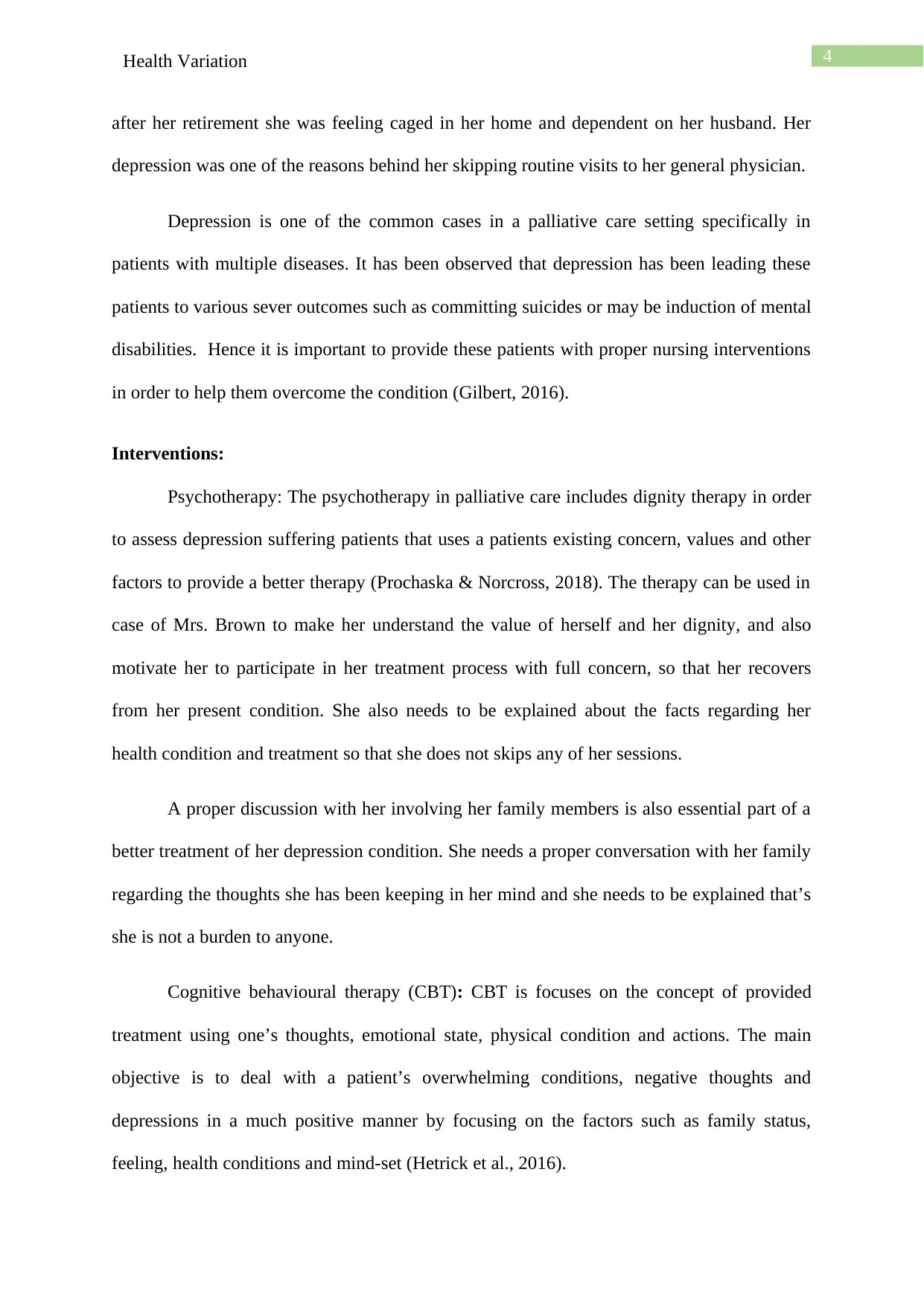
4Health Variation
after her retirement she was feeling caged in her home and dependent on her husband. Her
depression was one of the reasons behind her skipping routine visits to her general physician.
Depression is one of the common cases in a palliative care setting specifically in
patients with multiple diseases. It has been observed that depression has been leading these
patients to various sever outcomes such as committing suicides or may be induction of mental
disabilities. Hence it is important to provide these patients with proper nursing interventions
in order to help them overcome the condition (Gilbert, 2016).
Interventions:
Psychotherapy: The psychotherapy in palliative care includes dignity therapy in order
to assess depression suffering patients that uses a patients existing concern, values and other
factors to provide a better therapy (Prochaska & Norcross, 2018). The therapy can be used in
case of Mrs. Brown to make her understand the value of herself and her dignity, and also
motivate her to participate in her treatment process with full concern, so that her recovers
from her present condition. She also needs to be explained about the facts regarding her
health condition and treatment so that she does not skips any of her sessions.
A proper discussion with her involving her family members is also essential part of a
better treatment of her depression condition. She needs a proper conversation with her family
regarding the thoughts she has been keeping in her mind and she needs to be explained that’s
she is not a burden to anyone.
Cognitive behavioural therapy (CBT): CBT is focuses on the concept of provided
treatment using one’s thoughts, emotional state, physical condition and actions. The main
objective is to deal with a patient’s overwhelming conditions, negative thoughts and
depressions in a much positive manner by focusing on the factors such as family status,
feeling, health conditions and mind-set (Hetrick et al., 2016).
after her retirement she was feeling caged in her home and dependent on her husband. Her
depression was one of the reasons behind her skipping routine visits to her general physician.
Depression is one of the common cases in a palliative care setting specifically in
patients with multiple diseases. It has been observed that depression has been leading these
patients to various sever outcomes such as committing suicides or may be induction of mental
disabilities. Hence it is important to provide these patients with proper nursing interventions
in order to help them overcome the condition (Gilbert, 2016).
Interventions:
Psychotherapy: The psychotherapy in palliative care includes dignity therapy in order
to assess depression suffering patients that uses a patients existing concern, values and other
factors to provide a better therapy (Prochaska & Norcross, 2018). The therapy can be used in
case of Mrs. Brown to make her understand the value of herself and her dignity, and also
motivate her to participate in her treatment process with full concern, so that her recovers
from her present condition. She also needs to be explained about the facts regarding her
health condition and treatment so that she does not skips any of her sessions.
A proper discussion with her involving her family members is also essential part of a
better treatment of her depression condition. She needs a proper conversation with her family
regarding the thoughts she has been keeping in her mind and she needs to be explained that’s
she is not a burden to anyone.
Cognitive behavioural therapy (CBT): CBT is focuses on the concept of provided
treatment using one’s thoughts, emotional state, physical condition and actions. The main
objective is to deal with a patient’s overwhelming conditions, negative thoughts and
depressions in a much positive manner by focusing on the factors such as family status,
feeling, health conditions and mind-set (Hetrick et al., 2016).
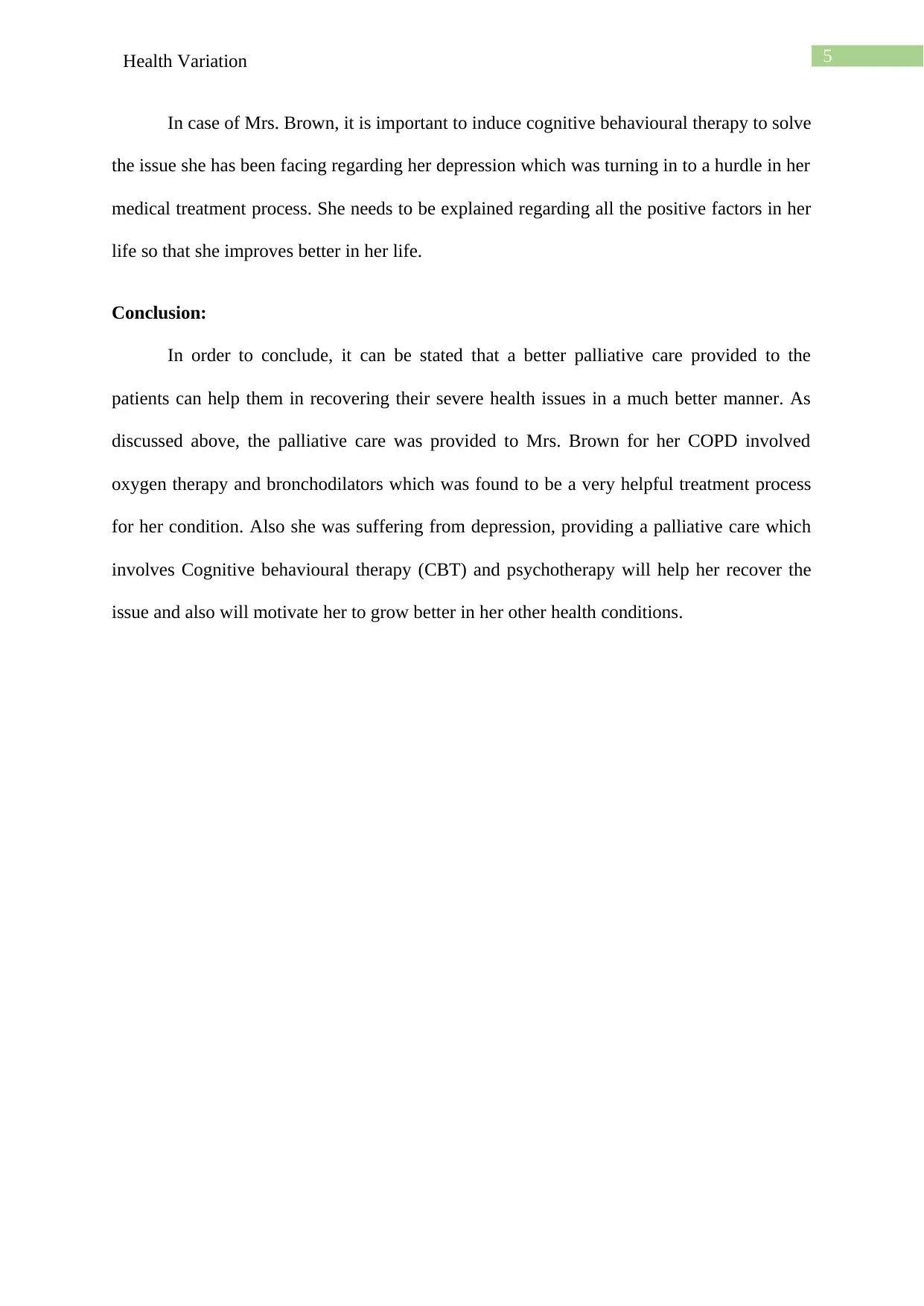
5Health Variation
In case of Mrs. Brown, it is important to induce cognitive behavioural therapy to solve
the issue she has been facing regarding her depression which was turning in to a hurdle in her
medical treatment process. She needs to be explained regarding all the positive factors in her
life so that she improves better in her life.
Conclusion:
In order to conclude, it can be stated that a better palliative care provided to the
patients can help them in recovering their severe health issues in a much better manner. As
discussed above, the palliative care was provided to Mrs. Brown for her COPD involved
oxygen therapy and bronchodilators which was found to be a very helpful treatment process
for her condition. Also she was suffering from depression, providing a palliative care which
involves Cognitive behavioural therapy (CBT) and psychotherapy will help her recover the
issue and also will motivate her to grow better in her other health conditions.
In case of Mrs. Brown, it is important to induce cognitive behavioural therapy to solve
the issue she has been facing regarding her depression which was turning in to a hurdle in her
medical treatment process. She needs to be explained regarding all the positive factors in her
life so that she improves better in her life.
Conclusion:
In order to conclude, it can be stated that a better palliative care provided to the
patients can help them in recovering their severe health issues in a much better manner. As
discussed above, the palliative care was provided to Mrs. Brown for her COPD involved
oxygen therapy and bronchodilators which was found to be a very helpful treatment process
for her condition. Also she was suffering from depression, providing a palliative care which
involves Cognitive behavioural therapy (CBT) and psychotherapy will help her recover the
issue and also will motivate her to grow better in her other health conditions.
⊘ This is a preview!⊘
Do you want full access?
Subscribe today to unlock all pages.

Trusted by 1+ million students worldwide
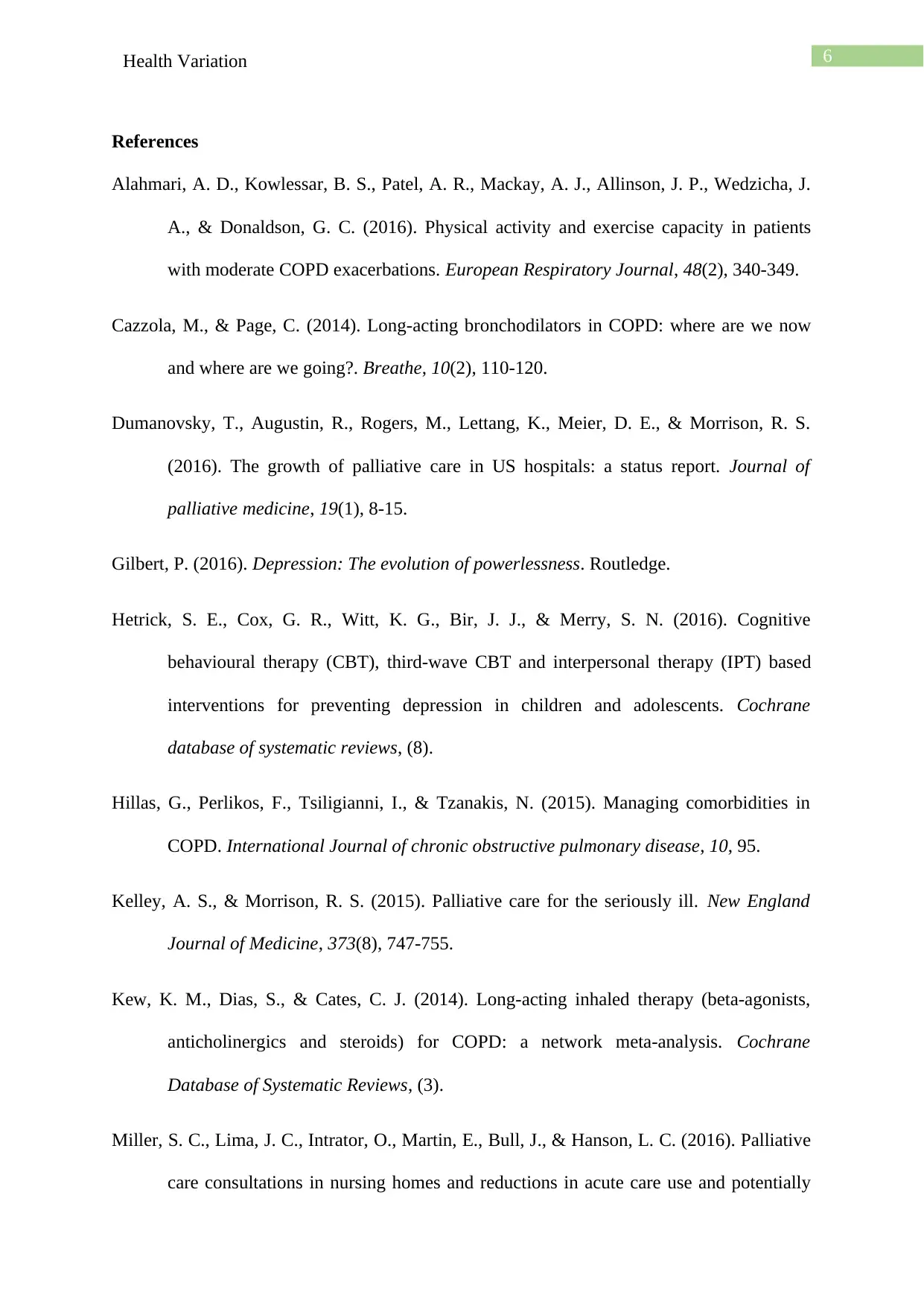
6Health Variation
References
Alahmari, A. D., Kowlessar, B. S., Patel, A. R., Mackay, A. J., Allinson, J. P., Wedzicha, J.
A., & Donaldson, G. C. (2016). Physical activity and exercise capacity in patients
with moderate COPD exacerbations. European Respiratory Journal, 48(2), 340-349.
Cazzola, M., & Page, C. (2014). Long-acting bronchodilators in COPD: where are we now
and where are we going?. Breathe, 10(2), 110-120.
Dumanovsky, T., Augustin, R., Rogers, M., Lettang, K., Meier, D. E., & Morrison, R. S.
(2016). The growth of palliative care in US hospitals: a status report. Journal of
palliative medicine, 19(1), 8-15.
Gilbert, P. (2016). Depression: The evolution of powerlessness. Routledge.
Hetrick, S. E., Cox, G. R., Witt, K. G., Bir, J. J., & Merry, S. N. (2016). Cognitive
behavioural therapy (CBT), third‐wave CBT and interpersonal therapy (IPT) based
interventions for preventing depression in children and adolescents. Cochrane
database of systematic reviews, (8).
Hillas, G., Perlikos, F., Tsiligianni, I., & Tzanakis, N. (2015). Managing comorbidities in
COPD. International Journal of chronic obstructive pulmonary disease, 10, 95.
Kelley, A. S., & Morrison, R. S. (2015). Palliative care for the seriously ill. New England
Journal of Medicine, 373(8), 747-755.
Kew, K. M., Dias, S., & Cates, C. J. (2014). Long‐acting inhaled therapy (beta‐agonists,
anticholinergics and steroids) for COPD: a network meta‐analysis. Cochrane
Database of Systematic Reviews, (3).
Miller, S. C., Lima, J. C., Intrator, O., Martin, E., Bull, J., & Hanson, L. C. (2016). Palliative
care consultations in nursing homes and reductions in acute care use and potentially
References
Alahmari, A. D., Kowlessar, B. S., Patel, A. R., Mackay, A. J., Allinson, J. P., Wedzicha, J.
A., & Donaldson, G. C. (2016). Physical activity and exercise capacity in patients
with moderate COPD exacerbations. European Respiratory Journal, 48(2), 340-349.
Cazzola, M., & Page, C. (2014). Long-acting bronchodilators in COPD: where are we now
and where are we going?. Breathe, 10(2), 110-120.
Dumanovsky, T., Augustin, R., Rogers, M., Lettang, K., Meier, D. E., & Morrison, R. S.
(2016). The growth of palliative care in US hospitals: a status report. Journal of
palliative medicine, 19(1), 8-15.
Gilbert, P. (2016). Depression: The evolution of powerlessness. Routledge.
Hetrick, S. E., Cox, G. R., Witt, K. G., Bir, J. J., & Merry, S. N. (2016). Cognitive
behavioural therapy (CBT), third‐wave CBT and interpersonal therapy (IPT) based
interventions for preventing depression in children and adolescents. Cochrane
database of systematic reviews, (8).
Hillas, G., Perlikos, F., Tsiligianni, I., & Tzanakis, N. (2015). Managing comorbidities in
COPD. International Journal of chronic obstructive pulmonary disease, 10, 95.
Kelley, A. S., & Morrison, R. S. (2015). Palliative care for the seriously ill. New England
Journal of Medicine, 373(8), 747-755.
Kew, K. M., Dias, S., & Cates, C. J. (2014). Long‐acting inhaled therapy (beta‐agonists,
anticholinergics and steroids) for COPD: a network meta‐analysis. Cochrane
Database of Systematic Reviews, (3).
Miller, S. C., Lima, J. C., Intrator, O., Martin, E., Bull, J., & Hanson, L. C. (2016). Palliative
care consultations in nursing homes and reductions in acute care use and potentially
Paraphrase This Document
Need a fresh take? Get an instant paraphrase of this document with our AI Paraphraser
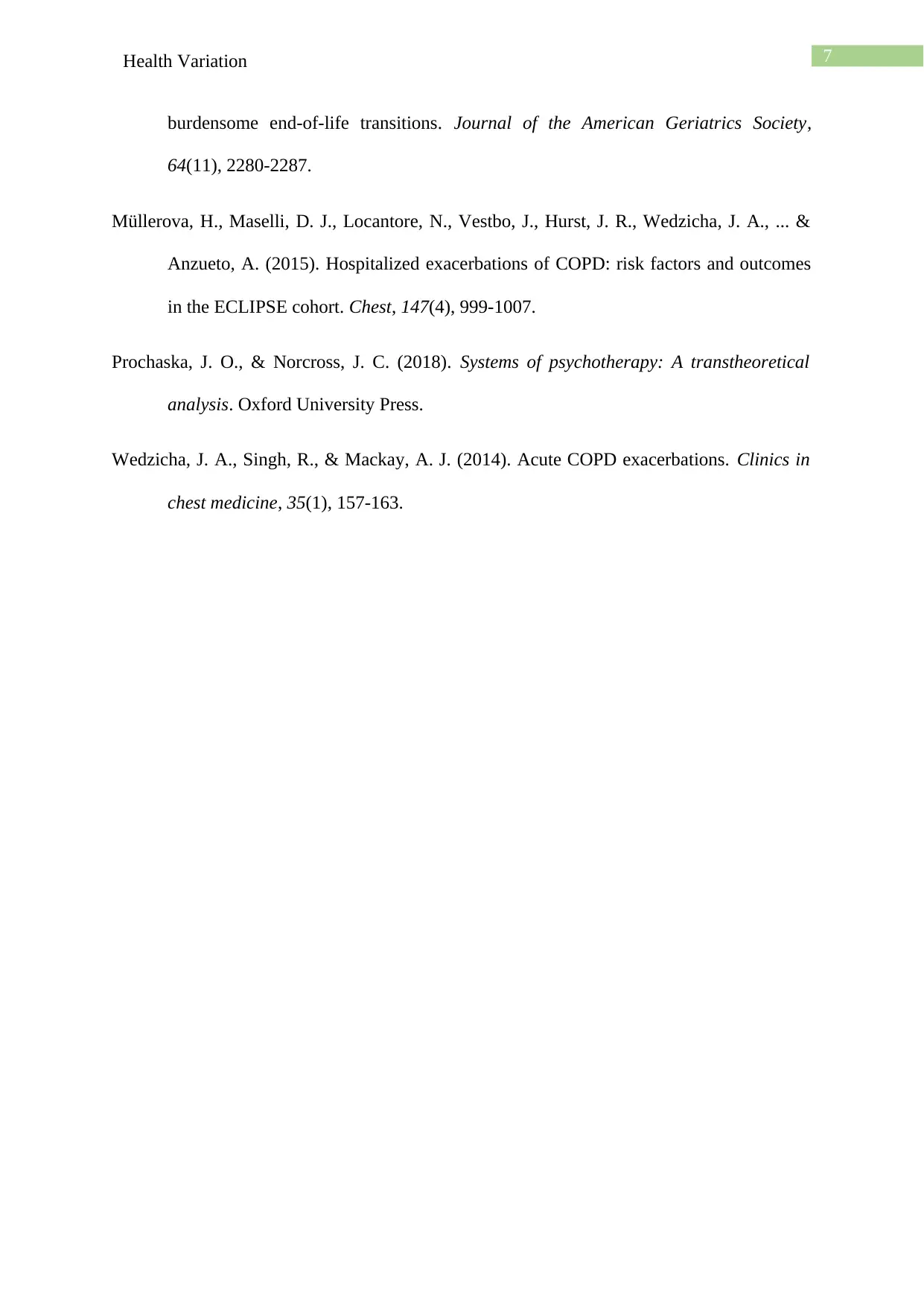
7Health Variation
burdensome end‐of‐life transitions. Journal of the American Geriatrics Society,
64(11), 2280-2287.
Müllerova, H., Maselli, D. J., Locantore, N., Vestbo, J., Hurst, J. R., Wedzicha, J. A., ... &
Anzueto, A. (2015). Hospitalized exacerbations of COPD: risk factors and outcomes
in the ECLIPSE cohort. Chest, 147(4), 999-1007.
Prochaska, J. O., & Norcross, J. C. (2018). Systems of psychotherapy: A transtheoretical
analysis. Oxford University Press.
Wedzicha, J. A., Singh, R., & Mackay, A. J. (2014). Acute COPD exacerbations. Clinics in
chest medicine, 35(1), 157-163.
burdensome end‐of‐life transitions. Journal of the American Geriatrics Society,
64(11), 2280-2287.
Müllerova, H., Maselli, D. J., Locantore, N., Vestbo, J., Hurst, J. R., Wedzicha, J. A., ... &
Anzueto, A. (2015). Hospitalized exacerbations of COPD: risk factors and outcomes
in the ECLIPSE cohort. Chest, 147(4), 999-1007.
Prochaska, J. O., & Norcross, J. C. (2018). Systems of psychotherapy: A transtheoretical
analysis. Oxford University Press.
Wedzicha, J. A., Singh, R., & Mackay, A. J. (2014). Acute COPD exacerbations. Clinics in
chest medicine, 35(1), 157-163.
1 out of 8
Related Documents
Your All-in-One AI-Powered Toolkit for Academic Success.
+13062052269
info@desklib.com
Available 24*7 on WhatsApp / Email
![[object Object]](/_next/static/media/star-bottom.7253800d.svg)
Unlock your academic potential
Copyright © 2020–2025 A2Z Services. All Rights Reserved. Developed and managed by ZUCOL.





